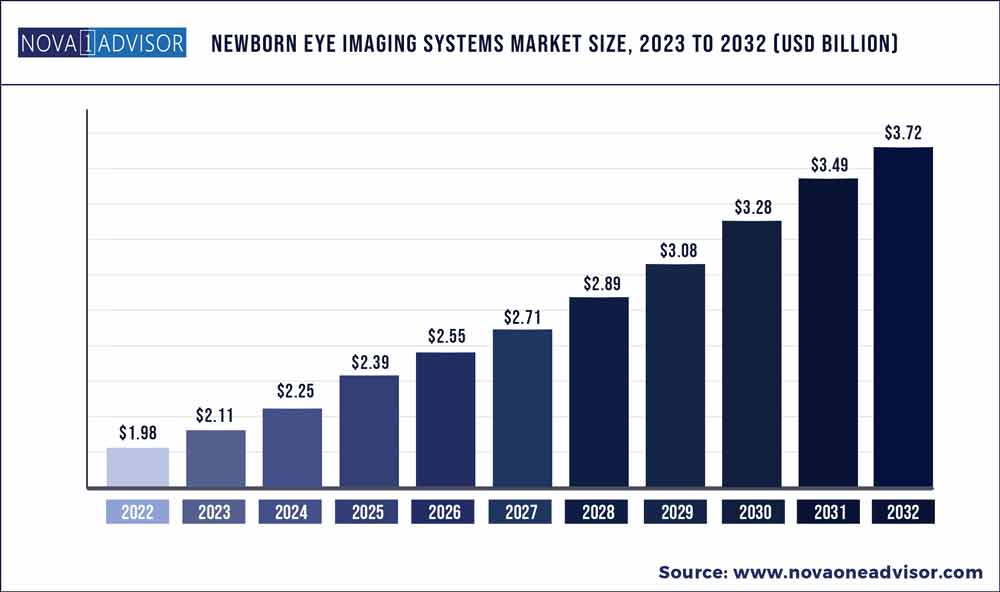The global newborn eye imaging systems market size was exhibited at USD 1.98 billion in 2022 and is projected to hit around USD 3.72 billion by 2032, growing at a CAGR of 6.51% during the forecast period 2023 to 2032.

Key Pointers:
- By geography, North America generated more than 34.79% of revenue share in 2022.
- By geography, Europe gained a notable share of around 25.68% in 2022 and will grow at the quickest rate from 2023 to 2032.
- By disease type, the ROP segment accounted for more than 37.41% of revenue share in 2022.
- By disease type, the retinal disease segment is progressing at a CAGR of 6.8% from 2023 to 2032.
- By device type, the basic device segment captured around 55.99% of revenue share in 2022.
- By device type, the wireless device segment is growing at a CAGR of 7.2% from 2023 to 2032.
- By end user, the hospital segment generated around 38.49% of revenue share in 2022.
- By end user, the ophthalmology & diagnosis center segment is growing at a CAGR of 6.9% from 2023 to 2032.
Newborn Eye Imaging Systems Market Report Scope
Eye imaging system is a type of device that helps in recognizing the eye related problems. The increasing number of the people that are suffering from various eye disorders has increased considerably. The new born babies also undergo from eye problems such as retinopathy of prematurity (ROP) which may result in the loss of eye sight and affects the blood cells.
The rapidly rising numbers of babies that are suffering from eye problems across the world is amongst the important factors intensifying the growth and demand of new born eye imaging systems market. In addition, the various market players in the new born eye imaging systems market are looming with advanced devices and technologies for the imaging purpose as well as are raising funds for the research activities which are also largely contributing to the growth in the global market over the forecast period of 2021 to 2028. Also, the growing number of new born population that is affected with eye related problems is also one of the significant factors fueling the growth of the new born eye imaging systems market.
The rapidly increasing approval of the product from respective organization and rapid technological advancements by various market players will further accelerate the expansion of the new born eye imaging systems market and are also are offering significant growth opportunities for the market in the forecast period of 2021 to 2028.
However, the high cost as well as lack of awareness regarding the product will curb the growth of the new born eye imaging systems market, whereas the dearth of trained professionals and increasing adoption of refurbished imaging systems have the potential to challenge the growth of the new born eye imaging systems market.
This new born eye imaging systems market report provides details of new recent developments, trade regulations, import export analysis, production analysis, value chain optimization, market share, impact of domestic and localized market players, analyses opportunities in terms of emerging revenue pockets, changes in market regulations, strategic market growth analysis, market size, category market growths, application niches and dominance, product approvals, product launches, geographic expansions, technological innovations in the market. To gain more info on new born eye imaging systems market contact Data Nova one advisor for an Analyst Brief, our team will help you take an informed market decision to achieve market growth.
Some of the prominent players in the Newborn Eye Imaging Systems Market include:
- Visunex Medical Systems
- Eye Photo Systems
- MergeHealthcare
- D-EYE
- Imagine Eyes
- Natus Medical
- Servicom Medical
Segments Covered in the Report
This report forecasts revenue growth at global, regional, and country levels and provides an analysis of the latest industry trends in each of the sub-segments from 2018 to 2032. For this study, Nova one advisor, Inc. has segmented the global Newborn Eye Imaging Systems market.
By Disease Type
- ROP
- Retinal Disease
- Strabismus
- Refractive Error
- Color Blindness
- Others
By Device Type
- Basic Device
- Wireless Device
By End-User
- Hospitals
- Ophthalmology Diagnosis Centers
- Ambulatory Surgical Centers
- Others
By Region
- North America
- Europe
- Asia-Pacific
- Latin America
- Middle East & Africa (MEA)

